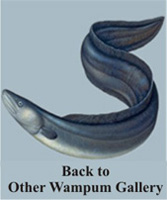 |
Photographs (left to right): Orange Park; Florida; Monhonk, New York; Orange Park, Florida
Wampum Belt Archive
Illini-Iroquois Belt


Musee de quai Branly, Paris, France
Original (left) Reproduction (right: Hamell, 7/20/10)
Original Size: |
Estimated Length: 33 inches by 5.5 inches. Fiber |
Reproduction: |
Beaded Length:40.5 inches. Width: 7.8 inches. Length w/fringe: 64.5 inches. |
Beads: |
Rows: 234. Width: 17. Total Beads: 3,978 |
Materials: |
Warp: Leather. Weave: Artificial Sinew. |
Description:
This is a Illini (Illinois Confederacy) belt which was previously mistaken as a Huron belt or Iroquois Belt woven with warps and vegetable fiber cords. The belt probably signifies a war alliance and had been attributed as a 17th Century.
Others have attributed its association with the first French (Champlain) and Huron contacts (Vitart-Fardoulis, 1983, pp. 145-146) although no documentation has been found to substantiate this claim. A similar belt is depicted in a 1688 engraving of the Cabinet of Curiosities of the Abbaye de Ste-Genevieve in Paris. It has also been attributed to the Four Nations of Hurons alliance with Champlain (1611). This association is unlikely as noted by several researchers (Lainey, 2011).
In Feest (2007) he stated:"It has long been believed original Huron and in relation to the four tribes Huron early seventeenth century. However, based on considerations stylistic, it would be most likely a belt from the Western Great Lakes region, and might be related to the four "clans" Ottawa. [...] eighteenth Century”.
Tehanetorens (1999) described it as an unknown belt (p.126) whereas Norman Hill (2008) of the Tonawanda Reservation identified it as the Hudson Bay Belt.
Chief Clinton Rickard (1973) in his book had also named the belt as the Hudson Bay Belt with three figures holding hands in friendship. It symbolized the trust of the White man and Hudson Bay Company with the Indians by allowing a trading post in their territory. The cross of the ‘new’ Whiteman's religion is set at a distance signifying that the Indians “did not immediately accept this new religion because they did not know if it would do good to their people. They said they would just watch this religion for a while and see what it was like.”
Jonathan Lainey (2011) stated the Hudson Bay Belt is ‘currently in Maniwaki in the hands of William Commanda’. Lainey supports Einhorn's (1974) interpretation that the “belt concerned Kanesatake, BEFORE (Lainey's emphasis) the Algonquins moved north to Kitigan Zibi (Maniwaki) in the 1850's”. The three people holding hands would be in this case the Mohawk, the Algonquins and the Nepissing, the three Aboriginal peoples that used to leave in Kanesatake. The cross ("T") is the Church.
References
Einhorn, Arthur. 1974. Iroquois-Algonquin Wampum Exchanges and Preservation in the 20th Century: a Case for in-situ Preservation. Man in the Northeast, pp.71-86.
Feest, C. F. 2007. American Indian Art Magazine First Nations, Royal Collection, v. 32.
Hill, Norman. 2008. Personal Communications.
Lainey, J. C. 2011. The so-called wampum offered Champlain and interpretation objects mystified. Biblioteque et Archives, Canada.
Lainey, Jonathan C. 2011. Personal Communications. Aboriginal Archives, Gatineau, Quebec. K1A ON4
Rickard, Chief Clinton. 1973. Fighting Tuscarora: the autobiography of Chief Clinton Rickard. Syracuse University Press, 182 pp.
Tehanetorens. 1999. Wampum Belts of the Iroquois. Book Publishing Company, Summertown, TN.
 |
 |
 |
 |
 |
 |
 |
 |
|---|